A commitment to fresh regional ingredients and high-meat formulations have helped make Acana one of the most frequently-recommended pet food brands on the market. But is it a good choice for your cat? Find out in our unbiased Acana cat food review.
The Cats.com Standard—Rating Acana on What Matters
We’ve analyzed Acana and graded it according to the Cats.com standard, evaluating the brand on species-appropriateness, ingredient quality, product variety, price, customer experience, and recall history. Here’s how it rates in each of those six key areas.
Ratings
- Species-Appropriateness – 7/10
- Ingredient Quality – 9/10
- Product Variety – 5/10
- Price – 7/10
- Customer Experience – 6/10
- Recall History – 6/10
Overall Score: 6.6/10
We give Acana cat food a 40 out of 60 rating or a B- grade.
About Acana
Acana is a cat and dog food brand created by Champion Petfoods, a Canadian company best known for high-meat, grain-free dry foods made from locally-sourced ingredients.
Champion Petfoods was created in 1985 by Canadian entrepreneur Reinhard Mühlenfeld. Originally a tiny operation serving local Alberta farmers, the company is now Canada’s largest pet food manufacturing company and sells to over 70 countries worldwide.
Champion Petfoods is behind two brands—Orijen and Acana. Compared to Orijen, Acana foods have lower meat content and prices, making it more accessible to buyers on a budget.
Sourcing and Manufacturing
Acana foods are made in Canada and the United States.
Buyers from the United States, Central America, and South America receive Acana food manufactured in the company’s DogStar kitchens located in Kentucky. Those living in Canada, Europe, and Asia buy Acana made in the company’s NorthStar kitchen, which is located in Alberta.
Because of the company’s commitment to fresh regional ingredients, the suppliers and formulations vary based on where it was made.
In this article, we’ll focus on the formulations produced in the company’s DogStar kitchen.
Champion’s DogStar kitchens are centrally located in Kentucky’s farming community, giving them access to fresh regional ingredients. According to the company, most Acana ingredients arrive at the DogStar kitchen within 48 hours of harvest. To store these fresh ingredients, the DogStar kitchens are equipped with 25,000 square feet of cooler space capable of holding over 500,000 pounds of fresh ingredients.
Acana refuses to outsource their manufacturing to co-packers and they don’t manufacture pet food for anyone else.
Has Acana Cat Food Been Recalled?
Acana hasn’t been recalled, but its sister brand, Orijen, has.
Prior to 2009, Australian import regulations required all raw or lightly-cooked imported foods undergo gamma irradiation treatment before being sold in stores. Because Orijen foods contain fresh and freeze-dried ingredients, they were subject to this mandatory irradiation treatment.
In 2008, the treatment destroyed more than microbial contaminants in Orijen food. It depleted vitamin A and promoted the formation and spread of free radicals. Combined, these effects led to illness—sometimes fatal illness—in several cats who ate the treated Orijen food.
In 2018, US consumers filed a lawsuit against Acana’s parent company, Champion Petfoods.
The class-action suit alleged that Champion misrepresented their food by failing to disclose the presence of heavy metals and toxins. Testing by the Clean Label Project revealed that both Orijen and Acana foods contained arsenic, BPA, cadmium, mercury, and lead. You may view documentation of those toxins here. The average amount of heavy metals in Orijen and Acana foods fell within the maximum tolerable levels set by the FDA.
What Kinds of Cat Food Does Acana Offer?
While Acana offers several lines for dogs, their cat food selection is limited to the Regionals line, which includes four recipes.
US-made Acana Regionals foods are inspired by regions of the United States, including Meadowland, Wild Atlantic, and Grasslands.
The Canadian lineup also includes four recipes, each inspired by regions of western Canada, including Wild Prairie, Pacifica, Grasslands, and Ranchlands.
All Regionals foods are at least 70% meat, half of which is fresh—never frozen, only refrigerated—or raw, which means it was frozen before processing. Muscle meat, organs, and cartilage are included in each recipe in what Acana calls “WholePrey ratios”.
Acana foods are minimally supplemented, containing added zinc, copper, and choline. Other necessary vitamins, minerals, and amino acids are provided by meat, organs, cartilage, and a variety of vegetables, fruits, and botanicals. They appear in the nutrient analysis, but not on the ingredient list.
Acana Cat Food – Top 3 Recipes Reviewed
| Product Name | Food Type | Price | Our Grade |
| Acana Regionals Meadowland | Dry | $5.60 per lb | B |
| Acana Regionals Grasslands | Dry | $6.00 per lb | B |
| Acana Regional Appalachian Ranch | Dry | $0.28 per oz | B |
What Do Customers Think of Acana Cat Food?
Acana receives mixed reviews. While the brand is generally well-regarded and gets primarily positive reviews, Acana has been hit by criticism since opening their DogStar kitchen in Auburn, Kentucky. Since the transition to the United States manufacturing plant, customers say that Acana foods taste different, look different, and, according to some, make their pets sick.
Here are four reviews from Acana customers:
Positive Reviews
“When I adopted my cat I wanted to feed her the best cat food out there, so I Googled Best Cat Food and Acana popped up. After a few weeks her coat was shiny and she looked healthier then when I adopted her. Even the vet said her coat was shiny and soft. Healthier food, healthier cat!” – Donna Brown, reviewing Acana Regionals Grasslands Cat Food
“I have been feeding it to our two cats for about a month and the oldest cat of 12 years, acts like she did when she was 5. More energy, fur not as oily, more alert…. I always looked at reviews that said what I just said as being a bit over-hyped but it’s true, just like with people, you eat better, you look better and you feel better. This is the best cat food we have ever tried and both cats love it. It has always been a challenge to find a food that BOTH of them like equally. Side note: We initially mixed it with their old food but they ended up not eating the old food, they just left it in the bowl. The food has a long expiration date so don’t be afraid to save some money and get the 12lb bag. We store the excess in air-tight Tupperware type containers.” – Vespasian, reviewing Acana Regionals Meadowland
Negative Reviews
“Something has been wrong with both of our cats since we switched to this food. They’ve had bloody diarrhea, have become picky eaters, are shedding more and are pooping like crazy. A high-quality food shouldn’t have them visiting the litter box 3x a day and filling it up – or pooping so much that they’ve started going on the floor. When we transitioned them to this food we did so slowly and properly and followed the feeding guidelines (not to over-feed). It has not worked. Since switching to a different food they’re back to normal. The thing is, when we lived in Canada we fed our cats Orijen and they were fine. Now that we live in the US it seems their American product is not up to the same standard.” – John Smith, reviewing Acana Appalachian Ranch
“Not cool. I’ve bought 4 of these bags now, and this one – the 4th – is all of a sudden making my cat sick as hell at both ends. I took the cat off this food, and sickness gone. Put cat back on just a little bit and BOOM there we are again. I’m going to request a refund and hopefully no other cats get sick from this same batch but something went very wrong and I’ll NOT be spending this much money on this brand anymore.” – Kyle S., reviewing Acana Regionals Grasslands
How Much Does Acana Cat Food Cost?
Acana is a moderately-priced cat food brand. According to the company’s feeding guidelines for an 11-lb cat, Acana costs about $0.64 to $0.75 per day. This puts Acana in the same price bracket as Merrick Backcountry, Taste of the Wild, and Wellness CORE grain-free dry cat food.
For those weighing Acana against its meatier and more expensive sibling, it’s about 20% cheaper than Orijen, saving you about $87 per year.
Overall, Is Acana a Good Choice?
Acana is one of the best dry cat food brands on the market. Acana’s unusually high meat inclusions, use of muscle meat, organs, and cartilage in WholePrey™ ratios, and relatively low carbohydrate content sets it apart from other kibble brands.
But Acana isn’t without its flaws. Although they offer a line of limited ingredient foods for dogs, Acana hasn’t yet launched a Singles line for cats. The brand’s emphasis on varied meat proteins may make it a poor choice for cats with food sensitivities and allergies.
Since Champion Petfoods opened their DogStar kitchen in the United States, the company has received a barrage of customer complaints. These quality control issues aren’t apparent in every bag, nor do they affect every cat, but they’re worth keeping in mind when considering Acana cat food.
Where Is Acana Cat Food Sold?
Both online and off, Acana is exclusively sold through independent pet specialty retailers and veterinary practices.
Both authorized and non-authorized dealers sell Acana. The company claims, however, that authorized retailers provide superior customer service and the Champion Petfoods 100% satisfaction guarantee. Non-authorized dealers include, but aren’t limited to, Chewy/PetSmart, Jet, Walmart, and eBay.
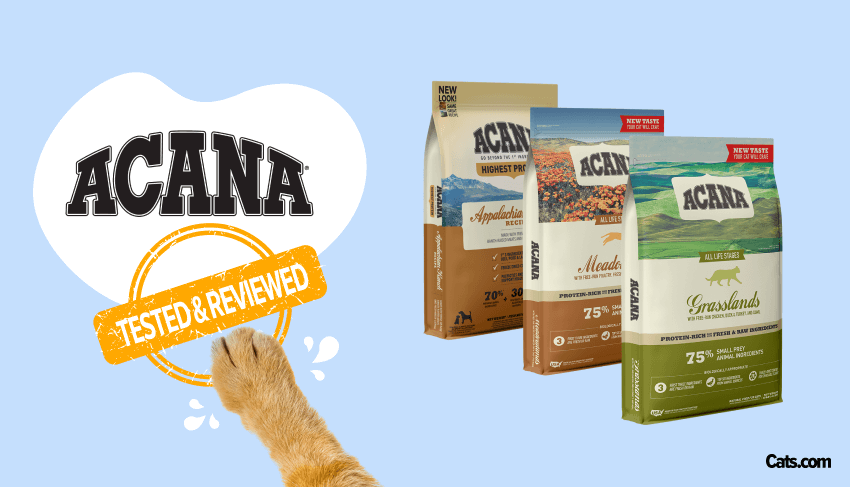
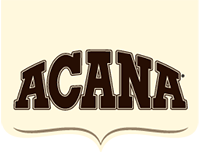
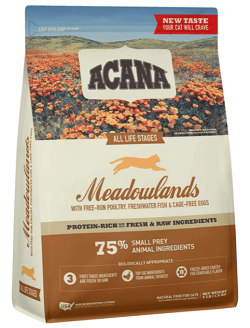
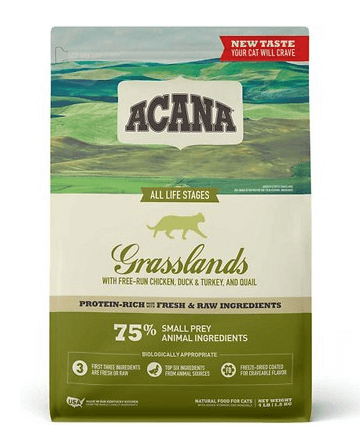
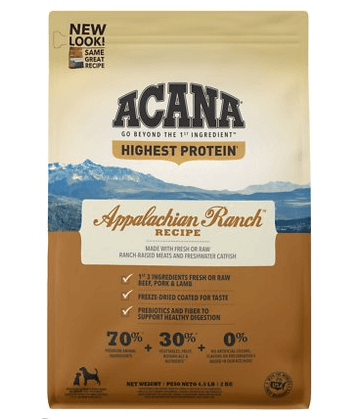
Can you do a review on there new canned wet food please?
Thomas, that’s a great idea. We’ll plan to review Acana’s new wet cat food soon. Thanks.
Hi did you happen to do a review on their wet food ?
HI! Yes, could you review ACANA’s new kitten wet food please??
Hi Stacey, Mallory will no longer be replying to comments but I’m happy to help you out! I’ve notified our editorial team that this review should be updated to include Acana’s new wet food products. In the meantime, here are some of my thoughts on the kitten food you mentioned:
At first glance, it’s a high-protein option with plenty of animal protein and healthy fats (including omega-3s from fish oil). It’s pretty calorie-dense at around 37 kcal/oz and I love the moisture content. Calculated as dry matter, it contains 50% protein and 35% fat, so it’s a low-carb option. There’s some concern about tuna-based cat foods and mercury content, but it’s hard to say without knowing what kind of tuna Acana uses.
Overall, however, it seems to be a more species-appropriate choice than Acana’s dry food. If you try it, let us know how you like it!
I will never buy this food again. Within 3 weeks of feed ing my cats, my female cat got a UTI, 5 days later my male got a full blockage. I blame this 100% due to feeding my cats 100% raw for 5 years. Decided to try to make my life easier by feeding kibble.
Never again. Ra
w all the way.
Appalachian Ranch is a dog food; not a cat food.
Yikes, thank you for pointing that out, Peter! Correcting now.
Thanks for the review!
I have been giving the wet food to my cat who didn’t want to eat her dry food (not Acana) and since she is really excited about eating.
It’s really a pleasure to see her love eating again, her brother also likes it.
I was thinking about changing the dry base to Acana… am hesitating between Acana or N&D fish…
What is the best kitten no grains wet food or kibble?? For Maine coon cats especially??
Hi Jayne, we have a full article on the best kitten food here.
Hi Mallory!
Thanks for review.
What’s your opinion about Nutram recipes?
Their recipes seem to be thoughtfully formulated, and while we generally don’t recommend dry foods, they seem to be made from pretty high-quality ingredients. Overall, it looks like an above-average brand and an okay choice if you want to feed your cat dry. The wet food seems a bit unnecessarily plant-heavy to me.
Great review. I would like to independently test cat food for contaminants and could use your help in looking for the right lab to do so. Can you help me understand what should I be looking for when searching for a lab? Need to test for contaminants and toxins.
Any help would be appreciated. thanks!
Hi Agata, that’s a good question. We’re still working on understanding this ourselves, but we are generally looking for labs that:
– Have worked with pet food in the past.
– Are able to bring a scientist onto their introductory call with you.
– Have certifications showing that they adhere to standard safety and quality practices.
– Ideally, have customer reviews indicating that they offer good service.
In the comments you said you were fixing your mistake putting dog food on the list, but it is still there. That can confuse people
Thank you for the reminder! I just scheduled this for an update.
The lawsuit they had in 2018 kinda scares me into not trying their cat food.
Hi Mallory,
Two comments:
-Please review Acana’s canned food. There are three new flavors, I think.
-Can you please do some kind of updated “Indoor” or “Neutered Male, Fat Cat” food list?
I would really enjoy it if you included ideas and tips to help control one’s cat’s appetite when he wants more food.
How would you organize your home if it were a multiple cat household with today’s automatic feeders, or perhaps not?
I saw that you did an article awhile back, but it basically listed the same foods that are on the Top Ten which are calorically high.
I have three active young males 2/3 have weight problems; the fat cat that eats like a rabid dog, very quickly; the second cat, who is big framed, that only wants to eat dry (so I need a low-calorie food for his big tummy); and cat #3 fortunately stays slim. I think I need to buy a Sure Feed Microchip Feeder for two of them, and CT Cat Mate 500 dish feeder for the dry food eater.
I always love your articles and try to buy your recommendations for my cats. I’ve learned so much from you! Thanks! 🙂
Do not use acana cat food used it 2 months it caused crystals in both my cats and huge vet bills
Sorry to hear that, Harold! Did your vet confirm that the food was directly linked to the issue?
Hi Mallory,
I have 2 cats and have been feeding them hills science plan dry food and twice weekly hills wet food, i recently purchased Acana wild praire , however one of my cats doesnt like it. He will eat some Acana if I mix Acana with Hills
, which I dont know if that is a good thing doing as he doesnt have it on its own
None of the other dry food you mentioned in your other videos are available in South Africa,
Please advise on what I could do, as I would like to give my cats the best possible nutrition that they need
Looking forward to hearing from you
Kind regards
Ricardo
Hi Ricardo! Sometimes the best food for your cat is the one they will actually eat. Hills products are formulated to meet your cat’s nutritional needs, and if they like it that’s great. There’s no issue with mixing the foods if your cat tolerates it–you might even use the Hills wet food as a mixer or topper to add some extra moisture and make the mixture more appealing.
Hi Kate, thank you for your response, i just feel that they desire hills as it is what i have been feeding my cats for years (my cats are 1 and 6 years old) but knowing now that there are foods which are better suited for what they actually need, i would think its best to transition them to it, however after reading about other people experiences on Acana and what Mallory mentioned on her review, I dont know what to do.
Is Hills not grain based as well? Which is not really ideal?
Thanking you
Regards
High-carb foods aren’t ideal for cats, you’re right. But something like Hill’s might be better for your cat in the long run than a meat-based product that isn’t nutritionally balanced. If Hill’s has kept your cats healthy so far and other options are limited, I don’t see a problem with continuing it.
Thank you so much for your in depth reviews, articles, and YouTube videos. The internet is so polarizing and confusing when it comes to pet food. So many blogs and websites that appear to be reputable sources, are wildly misleading and are funded by the big name brands themselves. Until my two cats now 13, started having various issues and I began researching how to best support them through diet, that’s when I came across your videos and learned just how corrupt the pet food industry is. Even more, your work has set me on a journey to educate myself on label laws, ingredients, etc. so I can use trustworthy databases and reviews like yours as a jumping off point and then do the research for myself.
One of my cats stopped eating wet food so I have to feed him dry. Even so he is very picky. His bloodwork came back normal but he is starting to lose weight. He also has Feline Idiopathic Cystitis and needs a urinary food. My vet strongly advised me put him on RX Royal Canin Urinary and Stress, which I really didn’t want to do after looking at the ingredients but she told me it would be best. She told me to leave the food out for him all day and give him as much as he’s willing to eat. Well, my other cat was very happy with this situation and steadily began gaining weight. He was always a big boy but let’s be honest, it wasn’t gaining muscle.
So I researched and researched and found Wysong Urinary, which is also low carb and high protein. I gradually switched them over with my vet’s approval. That has been going well. My hefty cat’s weight has leveled off and my kitty with Cystitis hasn’t had any severe episodes since switching foods. Unfortunately, it seems he’s now losing interest in the Wysong so I’m on the hunt for a second option to give him some variety. I’m trying to find a low carb-high protein, urinary friendly dry food, that isn’t filled with a bunch of junk and is highly palatable. I know, that’s asking A LOT! Anaca has come out with a high protein, grain free cat food but it’s so new that I can’t find unbiased info on it and I am unsure if it’s urinary safe. I’m curious if you have had a chance to check it out or if any other high quality, urinary, low carb foods come to mind off the top of your head. Thanks again for all you do!